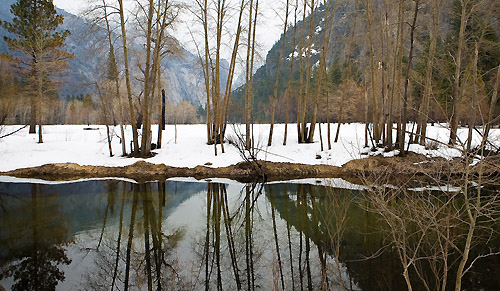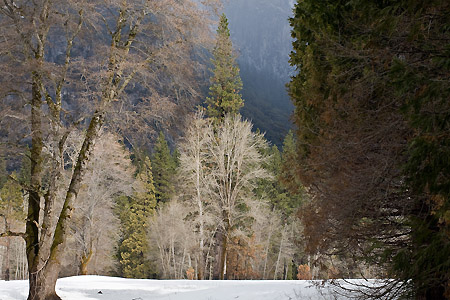I see all my fellow bloggers here seem caught up in color. Hmmm, still winter in some parts of the country ? <g> Now for me, well into spring here in Northern California, at the peak of daffodil season, I need a break to see winter. Bare trees, snow, and monotones to remind me of garden bones.

Merced River reflection, Yosemite National Park.
Sometimes I wonder why the heck I garden. I don’t wonder philosophically, I wonder out of abject humility. What am I doing trying to create beauty in a garden ! If I want a little beauty just go out into the wild. I hope all who read this will allow diversion into the natural world. Isn’t this the Gardening Gone Wild blog ?
And to take my camera into wild areas? What am I doing trying to capture beauty in the wild ! The beauty is not simply visual it is visceral. It transcends being fixed in time by a photograph. The beauty is felt in the heart, the loins, the inner part of the human brain that allows us to appreciate that which is greater than ourselves.
In the case of something as awe inspiring as Yosemite, a camera seems nearly useless to capture what is really there. The camera lies by no intention of the photographer but because it is inadequate to the task. Sure, many a photographer has taken many a pretty picture in Yosemite, but to capture the real beauty ? You do that with your eyes, ears, nose . . . and heart.
Very few of us are fortunate to actually live in a truly wild place and many of us garden to remind us of what we long for. Seeing, truly seeing a natural landscape gives us ideas to bring home. I firmly believe we get comfort from becoming familiar with natural areas and want that feeling in our gardens.
This is an idea for another day but I think the sense of place we get from acquainting ourselves with the wild, incubates our expectations in gardens. It is the reason so many Western gardeners do not garden appropriately – they come from the East or are influenced by Eastern style gardens seen in publications. And it is why it is so very important to get children out into natural areas, so they understand, in the innate way children absorb ideas, that gardens come from nature.
So, what does the gardener learn from a trip to Yosemite ? Reminders that many of the best gardening principles come from nature. Using reflections in water is an obvious one. Balance, space, borrowed scenery, quiet tones for calm and quiet moments, all are important garden design concepts.
I particularly like trees. Noticing trees in winter is the best way to plan a garden. I look at the trees in Yosemite Valley and marvel at the dark mass of lush conifers, able to frame a view and notice in stark alders, spreading oaks and the vertical spires of pines that all these are the bones of nature’s garden.
As spring gathers momentum where you are, and before the trees come into bloom and summer glory, walk your garden and think about the bones. Look through the garden knowing it will soon be full, look past the trees and past the houses. Walk the garden and let go of what you think is there. How does your garden connect to the world ? What will you do next to bring that world back to your garden? Plan now, the rush is upon us.

